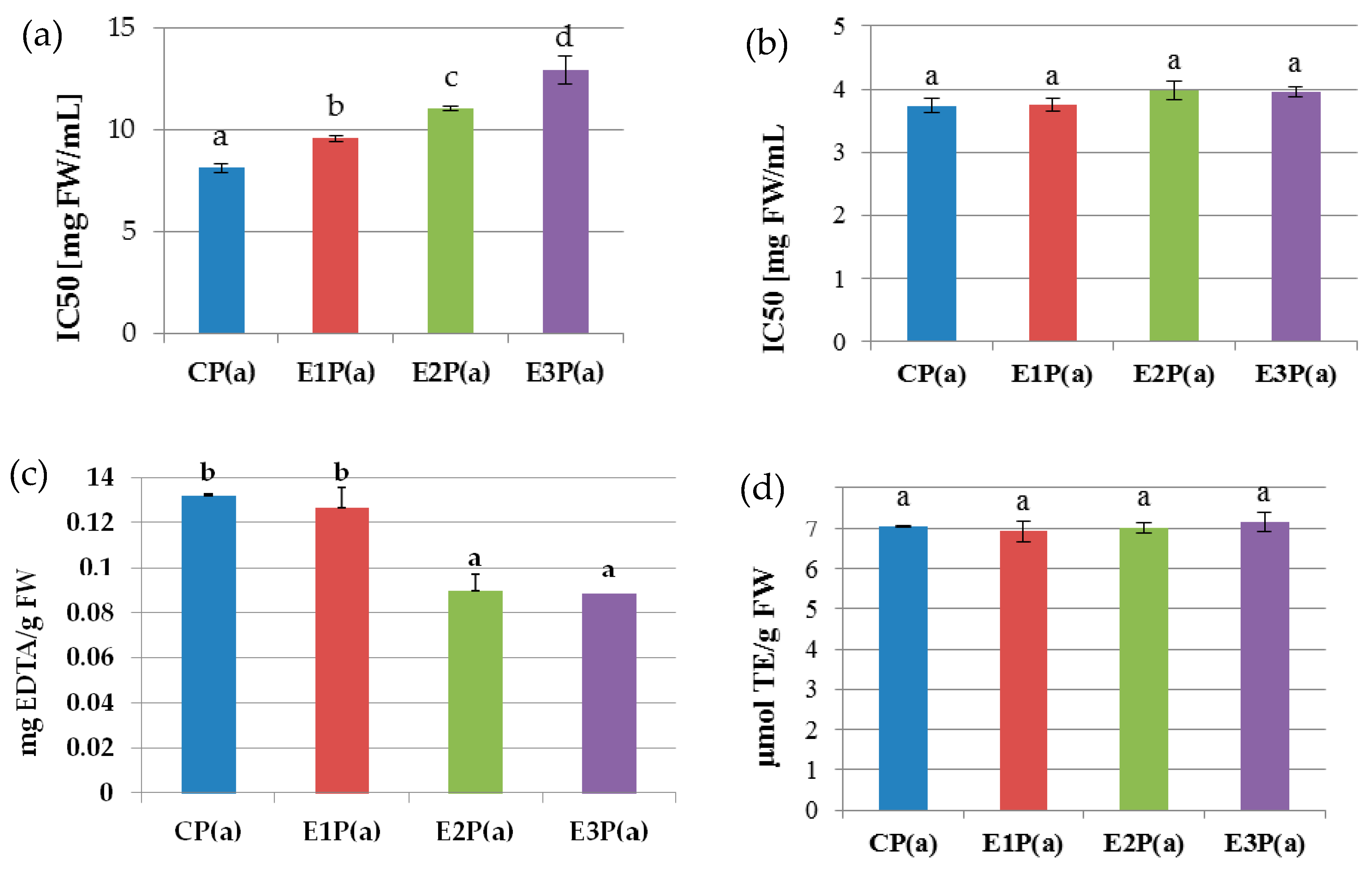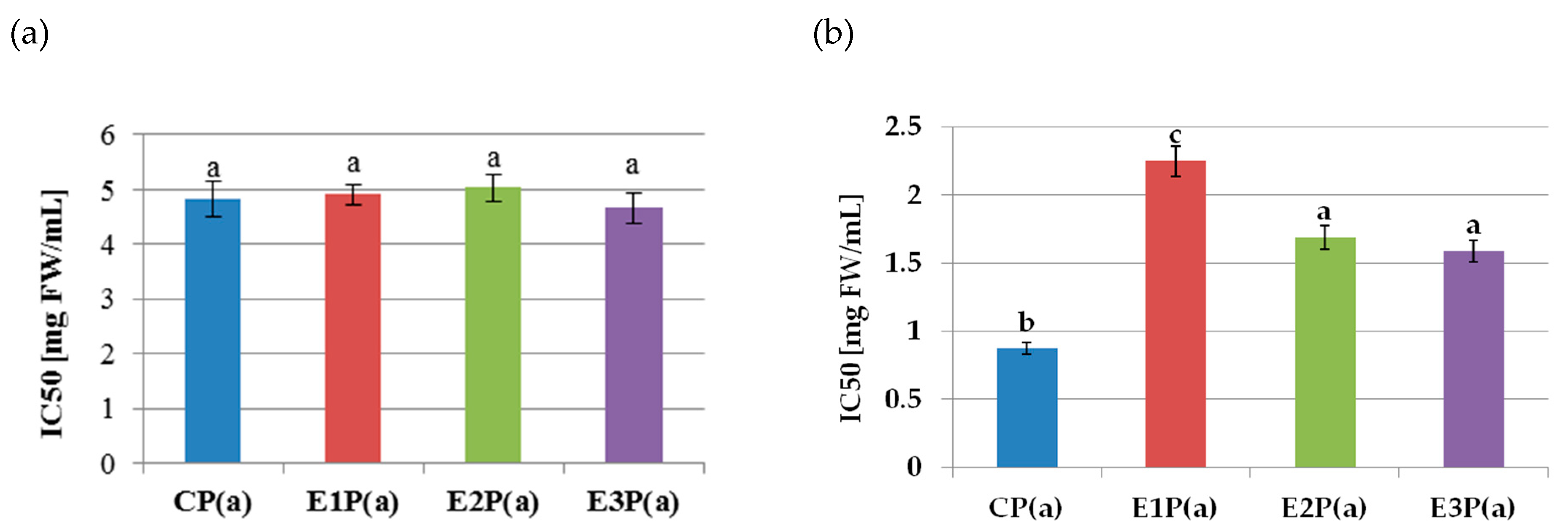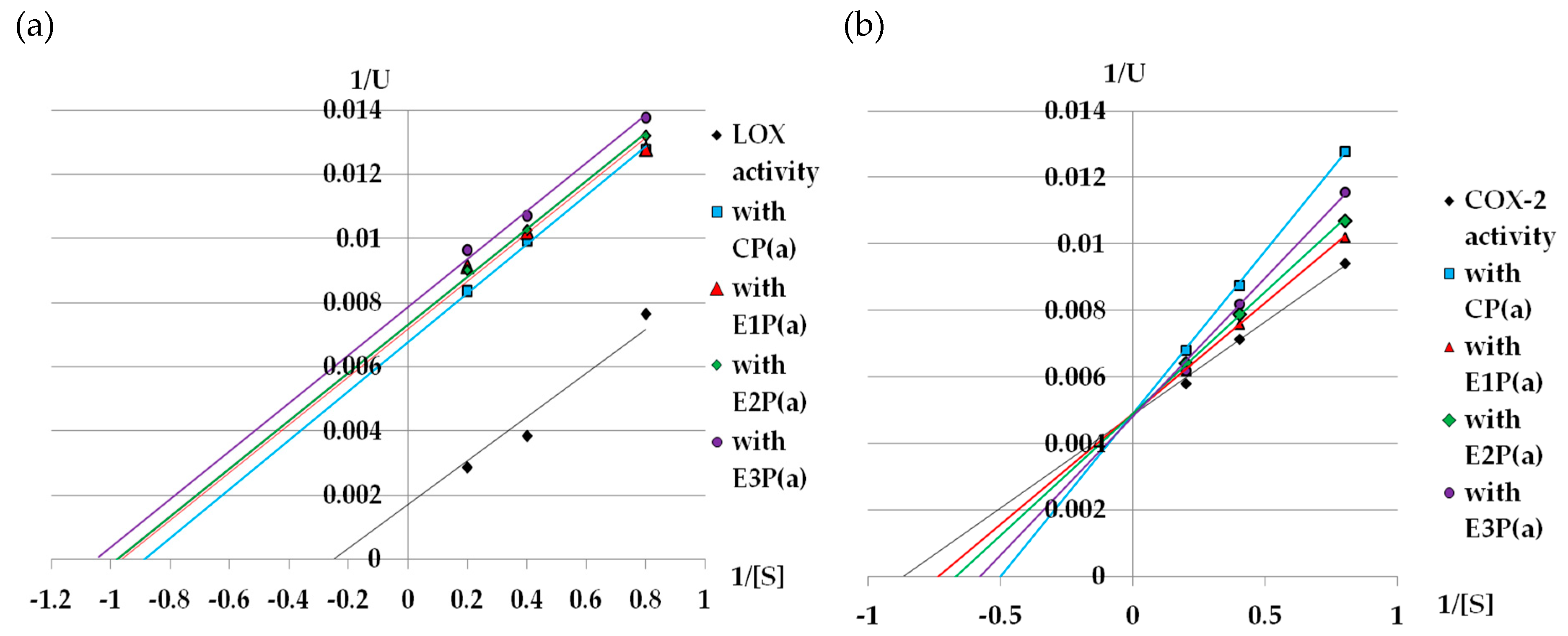Antioxidant and Potentially Anti-Inflammatory Activity of Anthocyanin Fractions from Pomace Obtained from Enzymatically Treated Raspberries
Abstract
:1. Introduction
2. Materials and Methods
2.1. Material
2.2. Sample Preparation
- C—control (distilled water instead of the enzymes)
- E1—Pectinex Ultra SP-L (polygalacturonase activity)
- E2—Pectinex Yield Mash (pectinmethylesterase activity)
- E3—Ultrazym AFP-L (polygalacturonase and cellulase activity)
2.3. Isolation of Phenolic Compounds
2.4. Analytical Methods
2.4.1. HPLC Analysis of Anthocyanins
2.4.2. Antioxidant Activity
2.4.3. Determination of Potential Anti-Inflammatory Properties
2.4.4. Determination of the Type of LOX and COX-2 Inhibition
2.5. Statistical Analysis
3. Results
3.1. Anthocyanin Composition
3.2. Antioxidant Properties of Purified Anthocyanin Fractions Isolated from Raspberry Pomace
3.3. Potential Anti-Inflammatory Properties of Purified Anthocyanin Fractions Isolated from Pomaces Obtained from Raspberries Subjected to Enzymatic Maceration
4. Discussion
5. Conclusions
Author Contributions
Funding
Acknowledgments
Conflicts of Interest
References
- Bower, C. Postharvest handling, storage, and treatment of fresh market berries. In Berry Fruit: Value-Added Products for Health Promotion, 1st ed.; Zhao, Y., Ed.; CRC Press: Boca Raton, FL, USA, 2007; pp. 261–290. [Google Scholar]
- Byamukama, R.; Kiremire, B.T.; Andersen, Ø.M.; Steigen, A. Anthocyanins from fruits of Rubus pinnatus and Rubus rigidus. J. Food Compos. Anal. 2005, 18, 599–605. [Google Scholar] [CrossRef]
- Schieber, A.; Stintzing, F.C.; Carle, R. By-products of plant food processing as a source of functional compounds—Recent developments. Trends Food Sci. Technol. 2001, 12, 401–413. [Google Scholar] [CrossRef]
- Helkar, P.B.; Sahoo, A.K.; Patil, N.J. Review: Food industry by-products used as a functional food ingredients. Int. J. Waste Resour. 2016, 6, 248. [Google Scholar] [CrossRef]
- Joshi, V.K.; Kumar, A.; Kumar, V. Antimicrobial, antioxidant and phytochemicalsfrom fruit and vegetable wastes: A review. Int. J. Food Ferment. Technol. 2012, 2, 123–136. [Google Scholar]
- Bobinaité, R.; Viškelis, P.; Venskutonis, P.R. Variation of total phenolics, anthocyanins, ellagic acid and radical scavenging capacity in various raspberry (Rubus spp.) cultivars. Food Chem. 2012, 132, 1495–1501. [Google Scholar] [CrossRef] [PubMed]
- Alov, P.; Tsakovska, I.; Pajeva, I. Computational studies of free radical-scavenging properties of phenolic compounds. Curr. Top. Med. Chem. 2015, 15, 85–104. [Google Scholar] [CrossRef] [PubMed]
- Foti, M.C. Antioxidant properties of phenols. J. Pharm. Pharmacol. 2007, 59, 1673–1685. [Google Scholar] [CrossRef] [PubMed]
- García-Lafuente, A.; Guillamón, E.; Villares, A.; Rostagno, M.A.; Martínez, J. A Flavonoids as anti-inflammatory agents: Implications in cancer and cardiovascular disease. Inflamm. Res. 2009, 58, 537–552. [Google Scholar] [CrossRef] [PubMed]
- Varzakas, T.; Zakynthinos, G.; Verpoort, F. Plant food residues as a source of nutraceuticals and functional foods. Foods 2016, 5, 88. [Google Scholar] [CrossRef]
- Buchert, J.; Koponen, J.M.; Suutarinen, M.; Mustranta, A.; Lille, M.; Törrönen, R.; Poutanen, K. Effect of enzyme-aided pressing on anthocyanin yield and profiles in bilberry and blackcurrant juices. J. Sci. Food Agric. 2005, 85, 2548–2556. [Google Scholar] [CrossRef]
- Rodriguez-Saona, L.E.; Wrolstad, R.E. Extraction, Isolation, and Purification of Anthocyanins. Current Protocols in Food Analytical Chemistry. F1.1.1-F1.1.11; John Wiley & Sons: Hoboken, NJ, USA, 2001. [Google Scholar]
- Szymanowska, U.; Baraniak, B.; Bogucka-Kocka, A. Antioxidant, anti-inflammatory, and postulated cytotoxic activity of phenolic and anthocyanin-rich fractions from Polana raspberry (Rubus idaeus L.) fruit and juice—in vitro Study. Molecules 2018, 23, 1812. [Google Scholar] [CrossRef] [PubMed]
- Brand-Williams, W.; Cuvelier, E.; Berset, C.M. Use of free radical method to evaluate antioxidant activity. LWT-Food Sci. Technol. 1995, 28, 25–30. [Google Scholar] [CrossRef]
- Re, R.; Pellegrini, N.; Proteggente, A.; Pannala, A.; Yang, M.; Rice-Evans, C. Antioxidant activity applying an improved ABTS radical cation decolorization assay. Free Rad. Biol. Med. 1999, 26, 1231–1237. [Google Scholar] [CrossRef]
- Guo, C.; Yang, J.; Wei, J.; Li, Y.; Xu, J.; Jiang, Y. Antioxidant activities of peel, pulp and seed fractions of common fruits as determined by FRAP assay. Nutr. Res. 2003, 23, 1719–1726. [Google Scholar] [CrossRef]
- Pulido, R.; Bravo, L.; Saura-Calixto, F. Antioxidant activity of dietary polyphenols as determined by a modified ferric reducing/antioxidant power assay. J. Agric. Food Chem. 2000, 48, 3396–3402. [Google Scholar] [CrossRef] [PubMed]
- Axelroad, B.; Cheesbrough, T.M.; Laakso, S. Lipoxygenase from soybeans: EC 1.13.11.12 linoleate: Oxygen oxidoreductase. Meth. Enzymol. 1981, 71, 441–451. [Google Scholar] [CrossRef]
- Balasundram, N.; Sundram, K.; Samman, S. Phenolic compounds in plants and agri-industrial by-products: Antioxidant activity, occurrence, and potential uses. Food Chem. 2006, 99, 191–203. [Google Scholar] [CrossRef]
- Brodowska, A.J. Raspberry pomace—Composition, properties and application. Eur. J. Biol. Res. 2017, 7, 86–96. [Google Scholar] [CrossRef]
- Četojević-Simin, D.D.; Velićanski, A.S.; Cvetković, D.D.; Markov, S.L.; Ćetković, G.S.; Tumbas Šaponjac, V.T.; Vulić, J.J.; Čanadanović-Brunet, J.M.; Djilas, S.M. Bioactivity of meeker and Willamette raspberry (Rubus idaeus L.) pomace extracts. Food Chem. 2014, 166, 407–413. [Google Scholar] [CrossRef]
- Cinar, I. Effects of cellulase and pectinase concentrations on the colour yield of enzyme extracted plant carotenoids. Proc. Biochem. 2005, 40, 945–949. [Google Scholar] [CrossRef]
- Helbig, J. Production of colour-intensive and colour-stable coloured juices. Fruit Process. 2001, 9, 342–347. [Google Scholar]
- Koponen, J.M.; Buchert, J.; Poutanen, K.S.; Törrönen, A.R. Effect of pectinolytic juice production on the extractability and fate of bilberry and black currant anthocyanins. Eur. Food Res. Technol. 2008, 227, 485–494. [Google Scholar] [CrossRef]
- Holtung, L.; Grimmer, S.; Aaby, K. Effect of processing of black currant press-residue on polyphenol composition and cell proliferation. J. Agric. Food Chem. 2011, 59, 3632–3640. [Google Scholar] [CrossRef]
- Landbo, A.K.; Meyer, A.S. Effects of different enzymatic maceration treatments on enhancement of anthocyanins and other phenolics in black currant juice. Innov. Food Sci. Emerg. Technol. 2004, 5, 503–513. [Google Scholar] [CrossRef]
- Laroze, L.; Soto, C.; Zúñiga, M.E. Phenolic antioxidants extraction from raspberry wastes assisted by enzymes. Electron. J. Biotechn. 2010, 13, 11–12. [Google Scholar] [CrossRef]
- Puupponen-Pimiä, R.; Nohynek, L.; Ammann, S.; Oksman-Caldentey, K.M.; Buchert, J. Enzyme-assisted processing increases antimicrobial and antioxidant activity of bilberry. J. Agric. Food Chem. 2008, 56, 681–688. [Google Scholar] [CrossRef]
- Versari, A.; Biesenbruch, S.; Barbanti, D.; Farnellc, P.J.; Galassid, S. Effects of pectolytic enzymes on selected phenolic compounds in strawberry and raspberry juices. Food Res. Int. 1997, 30, 811–817. [Google Scholar] [CrossRef]
- Chen, L.; Xin, X.; Zhang, H.; Yuan, Q. Phytochemical properties and antioxidant capacities of commercial raspberry varieties. J. Funct. Foods 2013, 5, 508–515. [Google Scholar] [CrossRef]
- Määttä-Riihinen, K.; Kamal-Eldin, A.; Torronen, A.R. Identification and classification of phenolic compounds in berries of Fragaria and Rubus species (family Rosaceae). J. Agric. Food Chem. 2004, 52, 6178–6187. [Google Scholar] [CrossRef]
- Kassim, A.; Poette, J.; Paterson, A.; Zait, D.; McCallum, S.; Woodhead, M.; Smith, K.; Hackett, C.; Graham, J. Environmental and seasonal influences on red raspberry anthocyanin antioxidant contents and identification of quantitative traits loci (QTL). Mol. Nutr. Food Res. 2009, 53, 625–634. [Google Scholar] [CrossRef]
- Remberg, S.F.; Sonsteby, A.; Aaby, K.; Heide, O.M. Influence of postflowering temperature on fruit size and chemical composition of glen ample raspberry (Rubus idaeus L.). J. Agric. Food Chem. 2010, 58, 9120–9128. [Google Scholar] [CrossRef]
- Rao, A.V.; Snyder, D.M. Raspberries in human health: A review. J. Agric. Food Chem. 2010, 58, 3871–3883. [Google Scholar] [CrossRef]
- Mildner-Szkudlarz, S.; Bajerska, J.; Górnaś, P.; Segliᶇa, D.; Pilarska, A.; Jesionowski, T. Physical and bioactive properties of muffins enriched with raspberry and cranberry pomace powder: A promising application of fruit by-products rich in biocompounds. Plant. Food Hum. Nutr. 2016, 71, 165–173. [Google Scholar] [CrossRef]
- Martin, J.; Kuskoski, E.M.; Navas, M.J.; Asuero, A.G. Antioxidant capacity of anthocyanin pigments. In Flavonoids; Justino, J.C., Ed.; Intech: Rijeka, Croatia, 2017; pp. 205–255. [Google Scholar]
- Četojević-Simin, D.; Ranitović, A.; Cvetković, D.; Markov, S.; Vinčić, M.; Djilas, S. Bioactivity of blackberry (Rubus fruticosus L.) pomace: Polyphenol content, radical scavenging, antimicrobial and antitumor activity. APTEEF 2017, 48, 63–76. [Google Scholar] [CrossRef]
- Jazić, M.; Kukrić, Z.; Vulić, J.; Četojević-Simin, D. Polyphenolic composition, antioxidant and antiproliferative effects of wild and cultivated blackberries (Rubus fruticosus L.) pomace. Int. J. Food Sci. Technol. 2019, 54, 194–201. [Google Scholar] [CrossRef]
- Tumbas, V.; Djilas, S.; Čanadanović-Brunet, J.; Ćetković, G.; Moreno, D.; Vulić, J.; Savatović, S. Antiradical and antihyperglycemic activity of raspberry pomace. Rev. Clin. Pharmacol. Drug Ther. 2012, 10, 109. [Google Scholar] [CrossRef]
- Vulić, J.J.; Tumbas, V.T.; Savatović, S.M.; Đilas, S.M.; Ćetković, G.S.; Ĉanadanović-Brunet, J.M. Polyphenolic content and antioxidant activity of the four berry fruits pomace extracts. APTEEF 2011, 42, 271–279. [Google Scholar] [CrossRef]
- González-Gallego, J.; Sánchez-Campos, S.; Tuñón, M.J. Anti-inflammatory properties of dietary flavonoids. Nutr. Hosp. 2007, 22, 287–293. [Google Scholar]
- Izzi, V.; Masuelli, L.; Tresoldi, I.; Sacchetti, P.; Modesti, A.; Galvano, F.; Bei, R. The effects of dietary flavonoids on the regulation of redox inflammatory networks. Front. Biosci. 2012, 17, 2396–2418. [Google Scholar] [CrossRef]
- Maiga, A.; Malterud, K.E.; Diallo, D.; Paulsen, B.S. Antioxidant and 15-lipoxygenase inhibitory activities of the Malian medicinal plants Diospyros abyssinica (Hiern) F. White (Ebenaceae), Lanella velutina A. Rich (Anacardiaceae) and Crossopteryx febrifuga (Afzel) Benth Rubiaceae. J. Ethnopharm. 2006, 104, 132–137. [Google Scholar] [CrossRef]
- Adhikari, D.P.; Francis, J.A.; Chandra, A.; Nair, M.G. Quantification and characterisation of cyclo-oxygenase and lipid peroxidation inhibitory anthocyanins in fruits of Amelanchier. Phytochem. Anal 2005, 16, 175–180. [Google Scholar] [CrossRef]
- Seeram, N.P.; Momin, R.A.; Nair, M.G.; Bourquin, L.D. Cyclooxygenase inhibitory and antioxidant cyanidin glycosides in cherries and berries. Phytomedicine 2001, 8, 362–369. [Google Scholar] [CrossRef]
- Knaup, B.; Oehme, A.; Valotis, A.; Schreier, P. Anthocyanins as lipoxygenase inhibitors. Mol. Nutr. Food Res. 2009, 53, 617–624. [Google Scholar] [CrossRef]



| Compound | Content of Individual Anthocyanins [µg/g FW] * | |||
|---|---|---|---|---|
| CP(a) | E1P(a) | E2P(a) | E3P(a) | |
| cyanidin-3-O-sophoroside | 255.6 ± 14.9 c | 178.5 ± 12.85 a | 156 ± 11.05 a | 214.4 ± 14.74 b |
| cyanidin-3-O-glucoside | 86.4 ± 5.04 b | 66.25 ± 4.77 a | 72 ± 5.1 a | 97.6 ± 6.71 b |
| cyanidin-3-O-rutinoside | 18.0 ± 1.05 c | 3.75 ± 0.27 b | 12 ± 0.85 a | 12.8 ± 0.88 a |
| Sum [mg/g FW] x | 0.36 ± 0.021 b | 0.25 ± 0.018 a | 0.24 ± 0.017 a | 0.32 ± 0.022 b |
| (a) | |||
| Inhibitor | Km (mM) | Vmax | LOX inhibition type |
| without inhibitor | 4.0 | 588.24 | - |
| CP(a) | 1.136 | 148.15 | uncompetitive |
| E1P(a) | 1.064 | 138.89 | uncompetitive |
| E2P(a) | 1.03 | 126.58 | uncompetitive |
| E3P(a) | 1.05 | 137.93 | uncompetitive |
| (b) | |||
| Inhibitor | Km (mM) | Vmax | COX-2 inhibition type |
| without inhibitor | 1.14 | 200 | - |
| CP(a) | 2.0 | 200 | competitive |
| E1P(a) | 1.37 | 200 | competitive |
| E2P(a) | 1.515 | 200 | competitive |
| E3P(a) | 1.724 | 200 | competitive |
© 2019 by the authors. Licensee MDPI, Basel, Switzerland. This article is an open access article distributed under the terms and conditions of the Creative Commons Attribution (CC BY) license (http://creativecommons.org/licenses/by/4.0/).
Share and Cite
Szymanowska, U.; Baraniak, B. Antioxidant and Potentially Anti-Inflammatory Activity of Anthocyanin Fractions from Pomace Obtained from Enzymatically Treated Raspberries. Antioxidants 2019, 8, 299. https://doi.org/10.3390/antiox8080299
Szymanowska U, Baraniak B. Antioxidant and Potentially Anti-Inflammatory Activity of Anthocyanin Fractions from Pomace Obtained from Enzymatically Treated Raspberries. Antioxidants. 2019; 8(8):299. https://doi.org/10.3390/antiox8080299
Chicago/Turabian StyleSzymanowska, Urszula, and Barbara Baraniak. 2019. "Antioxidant and Potentially Anti-Inflammatory Activity of Anthocyanin Fractions from Pomace Obtained from Enzymatically Treated Raspberries" Antioxidants 8, no. 8: 299. https://doi.org/10.3390/antiox8080299
APA StyleSzymanowska, U., & Baraniak, B. (2019). Antioxidant and Potentially Anti-Inflammatory Activity of Anthocyanin Fractions from Pomace Obtained from Enzymatically Treated Raspberries. Antioxidants, 8(8), 299. https://doi.org/10.3390/antiox8080299






